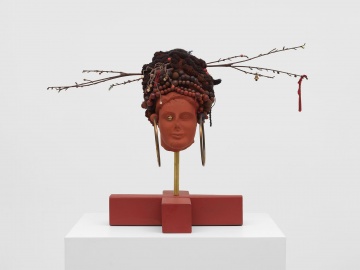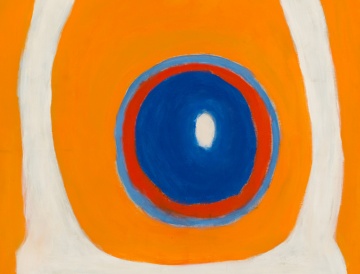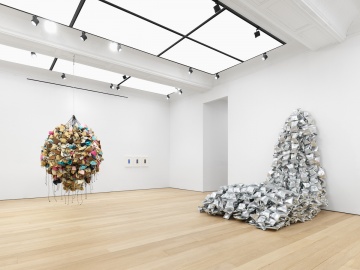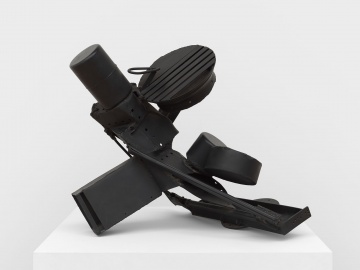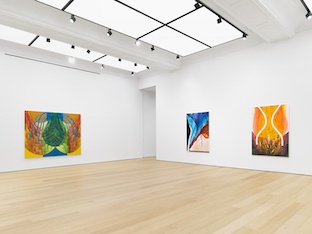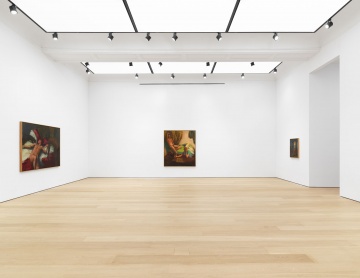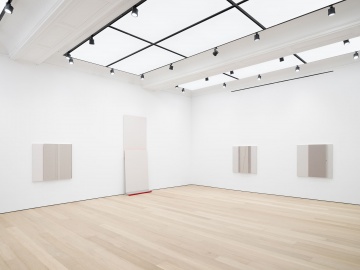Alexander Gray Associates
384 Broadway
New York, NY 10013
212 399 2636
New York, NY 10013
212 399 2636
Alexander Gray Associates is a contemporary art gallery in New York City and Germantown, NY. Through exhibitions, research, and artist representation, the Gallery spotlights artistic movements and artists active in the twentieth and twenty-first century. Influential in cultural, social, and political spheres, these artists are notable for creating work that crosses geographic borders, generational contexts, and artistic disciplines. Alexander Gray Associates is an organization committed to anti-racist and feminist principles.
Artists Represented:
Ricardo Brey
Ricardo Brey
Teresa Burga
Luis Camnitzer
Melvin Edwards
Coco Fusco
Harmony Hammond
Jennie C. Jones
Steve Locke
Lorraine O'Grady
Betty Parsons
Ronny Quevedo
Joan Semmel
Hassan Sharif
Regina Silveira
Valeska Soares
Hugh Steers
Works Available By:
Frank Bowling
Frank Bowling
Sam Gilliam
Jack Whitten
Ruby Sky Stiler
Ruby Sky Stiler: Long Pose
November 7, 2025 - December 20, 2025
Alexander Gray Associates, New York presents Ruby Sky Stiler: Long Pose, the artist’s first solo exhibition with the Gallery. The show features new paintings and a large-scale bas-relief mural that encircles the exhibition space. Together, these works expand Stiler’s exploration of art historical archetypes, as she recasts traditions of figuration and the nude through a contemporary lens. The exhibition’s title invokes the academic convention of life drawing from a posed model, highlighting Stiler’s ongoing dialogue with historical forms and techniques.
Stiler’s practice centers on the productive tension between abstraction and representation, and the interplay between flatness and dimensionality. Reworking Cubist fragmentation with classical and vernacular elements, she draws on her background in printmaking to create mosaic-like compositions assembled from hundreds of small, cropped drawings transferred into paint. The paintings on view are primarily rendered in shades of blue, with fractal-like geometries derived from subtle gradations that allow fine details to blend into harmonious compositions. The figures that emerge from these layered tapestries are clear yet precarious, as if on the verge of dissolving into pure form. As the artist explains, “They are almost falling apart into geometry—you take one thing away and they would be just shapes.”
This economy of form is evident in the exhibition's titular work Long Pose (2025), a bas-relief mural that unifies Stiler’s paintings within a linear architectural framework. Constructed from wood and painted in a warm earthen hue reminiscent of Pompeiian Red, it reflects Stiler's interest in the shifting nature of historical memory, as this ostensibly ancient color reveals as much about modern restoration as it does about Pompeii’s original palette. Long Pose's ruddy tone and sizeable proportions also recall monumental, weathered steel sculptures by artists like Richard Serra and Mark di Suvero—an imposing aesthetic that Stiler subtly resists. Though substantial in scope, Long Pose leaves the floor space navigable. Visually and materially, it remains light—sculpture, as the artist describes it, “that does not define your path; it does not push you around.” The abstracted, sinuous figures lining the walls are inspired by caryatids, the classical architectural form of female figures bearing structural weight. In Stiler’s hands, these forms move beyond gendered symbolism to become universal emblems of resilience.
Stiler's exploration of the politics of representation counts on a wide range of historical references, including Bauhaus architecture, Art Deco ornamentation, and the graphic patterns of Modernist designers such as Anni Albers and Alexander Girard. Alongside these allusions, her paintings incorporate intimate, diary-like drawings—her own spontaneous sketches, her children’s artwork, and imagery from popular children’s books. Drawing on Louise Nevelson’s collage ethos—defined by fragmentation, layering, and recontextualization—Stiler creates hand-assembled compositions that blur the lines between sculpture, collage, and installation.
Family and youth are recurrent themes throughout the exhibition. Stiler’s paintings offer expanded portrayals of kinship, depicting female-led social structures, solitary matriarchs, and father-child bonding. The patriarchal foundations of academic drawing and classical ideals of the male body are similarly addressed, while other works respond to these precedents from a distinctly feminist perspective, rejecting idealization in favor of novel ways of imagining the nude. With the exhibition Long Pose, Stiler invites viewers to reconsider familiar visual and cultural conventions—not as fixed symbols, but as evolving forms that bridge time and experience. By merging the personal with the historical, Stiler refines her distinctive visual language, creating a framework, as she notes, “where viewers can find connections and resonances that speak to our shared humanity.”
Stiler has been the subject multiple solo presentations, including New Patterns, The Frances Young Tang Teaching Museum and Art Gallery at Skidmore College, Saratoga Springs, NY (2022); Group Relief, Fairfield University Art Museum, CT (2020); Fresco, Saint-Gaudens Memorial Park, Cornish, NH (2019); Ghost Versions, The Aldrich Contemporary Art Museum, Ridgefield, CT (2015); and Inherited and Borrowed Types, Portland Institute for Contemporary Art, OR (2010), among others. Her work has been included in numerous group exhibitions including Friends & Lovers, FLAG Art Foundation, New York, NY (2023); No Forms, Hill Art Foundation, New York, NY (2022); Classic Beauty: 21st-Century Artists on Ancient [Greek] Form, Providence College Galleries, RI (2018); The Times, FLAG Art Foundation, NY (2017); We Are What We Hide, Institute of Contemporary Art, Maine College of Art & Design, Portland, ME (2013); and the Socrates Sculpture Park Emerging Artist Fellowship Exhibition, Socrates Sculpture Park, Queens, NY (2010), among others. Her work is in the collections of Fairfield University Art Museum, CT; Farnsworth Art Museum, Rockland, ME; The Frances Young Tang Teaching Museum and Art Gallery at Skidmore College, Saratoga Springs, NY; The Museum of Modern Art, New York, NY; and Rhode Island School of Design Museum, Providence, RI.
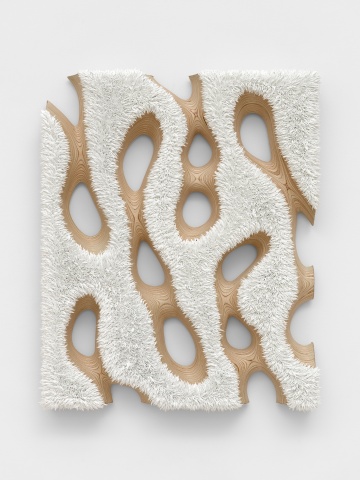
Donald Moffett:
Donald Moffett: Snowflake
September 12, 2025 - October 25, 2025
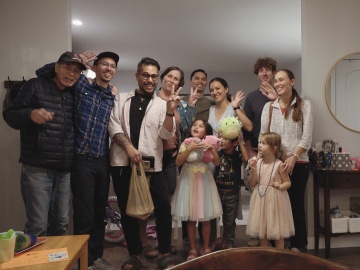
Chloë Bass
Chloë Bass: Twice Seen
June 13, 2025 - July 26, 2025
Alexander Gray Associates, New York, presents Chloë Bass: Twice Seen, the artist's first solo commercial exhibition. Debuting a 2024 multichannel video installation alongside new text-based prints and mirrored works, Bass's show is a multifaceted investigation into the nature of representation, positioning racial and cultural hybridity as foundational to American identity.
Born in 1984 to a Trinidadian abstract artist and poet and a Jewish psychoanalyst, Bass embodies the cultural hybridity at the heart of her exhibition. Her immersive four-channel video installation we turn to time, recently acquired by the Walker Art Center, combines self-documented recordings from four families across the United States. As Bass writes, “... [the work] is the discovery and presentation of an archive … that quintessential form of nostalgic visual culture, the family home movie, featuring visibly mixed race, intergenerational families throughout the United States.” The footage, captured at various gatherings, brims with laughter, quotidian tasks, contemplative gazes, and telling silences. By transforming these private moments into public meditations on identity, Bass's installation challenges historical and contemporary representations of America that elide the country's inherent racial complexities.
Bass’s work recalls that of conceptual artists like Adrian Piper, Yoko Ono, and Lorraine O'Grady (1934–2024), who was both a mentor and friend. Like these artists, Bass’s installation traces the connection between representation, visibility, and power. Created against the backdrop of the United States’ fraught history—where anti-miscegenation laws criminalized interracial relationships for centuries—her videos present mixed-race family life as quintessentially American. “Throughout American history, the mixed-race body is usually presented either as a disaster … or as a kind of magic,” she writes. “… we turn to time resists the binaries of tragic/magic, choosing instead to engage with the idea of mixture as fundamentally American.”
Bass's mirrors and letterpress prints, both titled PRETEXTS, further refine these ideas. The hand-silvered, obliquely engraved mirrors build on the artist's earlier Wayfinding installations, posing evocative statements to viewers that implicate them through reflection—incorporating them literally and figuratively into the exhibition's exploration of visibility. Meanwhile, Bass's prints describe scenes from a single 1960s-era archival home movie. Printed on salvaged offcuts from her mother’s print practice, these works use language and material to extend Bass's examination of how histories are recorded, emphasizing the gap between lived experience and representation. The texts for both the glass and letterpress works draw from the research and writing Bass did in preparation for we turn to time, including her 2018 lecture-performance at The Metropolitan Museum of Art, THIS IS A FILM.
Bass's work represents a profound exploration of identity and belonging. Through her video installation and text-based pieces, she dismantles conventional national narratives to offer a nuanced portrait of American selfhood—one that defies simple categorization. As Bass concludes, her art invites more comprehensive understandings of “…who we are, and who we could be.”
The artist’s work has been the subject of many one-person exhibitions, including Wayfinding, Buffalo AKG Art Museum, NY (2024); #sky #nofilter: Hindsight for a Future America, co-presented by Art + Practice and California African American Museum, Los Angeles, CA (2023); Wayfinding, Skirball Cultural Center, Los Angeles, CA (2022); Wayfinding, Pulitzer Arts Foundation, St. Louis, MO (2021); Wayfinding, St. Nicholas Park, The Studio Museum in Harlem, New York (2019); and The Book of Everyday Instruction, Knockdown Center, Queens, NY (2018), among others. The artist’s work has been featured in numerous group exhibitions, including Cantando Bajito: Chorus, Ford Foundation Gallery, New York, NY (2024); In These Truths, Albright-Knox Northland, Buffalo AKG Art Museum, NY (2022); Close to You, MASS MoCA, North Adams, MA (2022); and Art on the Grid, Public Art Fund, New York (2020), among others. Bass’s performances have been spotlighted at the Museum of Modern Art, New York, NY (2023); COUNTERPUBLIC, St. Louis, MO (2019); Zentrum für Kunst und Urbanistik, Berlin, Germany (2019); and The Metropolitan Museum of Art, New York, NY (2018), among others. Her work is in the collections of the Buffalo AKG Art Museum, NY and California African American Museum, Los Angeles, CA. She is the recipient of many awards and grants, including New York University Future Imagination Fund Fellowship (2022); Andrew W. Mellon Foundation Arts and Culture Grant for SPCUNY (2021); and Art Matters Fellowship (2019), among others. Bass’s major projects often culminate in publications. Working with collaborators, she has released #sky #nofilter (2020); The Book of Everyday Instruction (2018); Art as Social Action (2018); Say Something, Jamie (2018); What is shared, what is offered (2017); and The Bureau of Self-Recognition (2013). The artist is an Associate Professor of Art at Queens College, CUNY, where she has co-directed Social Practice Queens (SPQ) with Dr. Gregory Sholette since 2016 and established Social Practice CUNY (SPCUNY) in 2021.
Kang Seung Lee
Kang Seung Lee: Body of Memory
April 26, 2025 - May 31, 2025
Alexander Gray Associates presents Kang Seung Lee: Body of Memory, the artist’s first solo exhibition with the Gallery, featuring recent drawing, embroidery, assemblage, and video works honoring the expression and activism of his artistic predecessors. Acts of remembrance are central to Lee’s process as he explores how transnational queer histories may be recovered and preserved for the future—a deeply personal endeavor for an artist who came of age in the shadow of the AIDS epidemic.
In Body of Memory, Lee explores the aging queer body as a living archive, presenting human skin as a personal and political register that transforms over time. Anatomical imagery appears throughout the works on view, in which Lee combines artistic mediums and organic materials to forge intricate tableaux of queer networks. Close-cropped images of the body—eyes and nipples, wrinkles and topical rashes—join Lee's image bank of botanical illustrations, archival ephemera, photographs, and drawings and embroideries of pre-existing artworks.
Lee often erases the identity of deceased individuals in these appropriated images, inviting the viewer “to reimagine invisibility as potentiality.” This elegiac quality in his work is amplified by the artist’s reliance on materials connoting ritual and ceremony, such as handmade lacquered mulberry paper, antique gold-coated silk thread, and sambe—a traditional Korean hemp textile used in funerary rites.
Lee’s visual language extends to three-dimensional works, including wall-hanging compositions that unify multiple references within a single frame and expansive installations featuring layers of carefully arranged objects that spread out across horizontal surfaces. As the artist describes, there is a “constellation in each work that holds intergenerational memories and the resilience of queer genealogy carried across time and space.” In these assemblages, materials are also markers of history. A wide range of organic objects convey these stories—dried flowers, driftwood, tree bark, and seeds are sourced from a range of queer spaces, from cruising sites in public parks to the homes of Lee’s subjects. Meanwhile, stones, fossils, coral, and sea glass invoke geological deep time—a reference to cycles of death and rebirth.
The largest work on view is an installation that spans across a low-lying plinth, with elements hanging from the ceiling. It consolidates multiple vignettes of watercolors and graphite drawings on parchment, drawing from Lee’s repertoire of found and gathered objects to honor a range of artists including Feliciano Centurión, Hudinilson Jr., Martin Wong, and Tamotsu Yatō.
Lee's wall-hanging assemblages are equally complex. Their wood veneer backgrounds have distinctive patterns resulting from burls—growths on a tree caused by injury or disease. On these surfaces, Lee’s drawings are paired with luminous pearls and mother-of-pearl shells, expanding his metaphors of desire and trauma. For Lee, these images and objects impart resilience, signifying the delicate balance between fragility and strength.
Tenacity is also a key theme of the video Skin (2024), which presents a dynamic performance by Meg Harper, a dancer whose affiliation with the Merce Cunningham Dance Company dates to the 1960s. Close-ups of Harper’s creased and scarred skin highlight how time is etched onto the body. The suggestion that memory is both a mental and physical imprint is further emphasized by the appearance of emotive passages from Robert Glück’s book About Ed (2023), which recounts his partnership and friendship with the artist Ed Aulerich-Sugai during Ed’s physical decline and death from AIDS-related illness.
Body of Memory underscores Lee’s resistance to historical amnesia, with his works standing as tangible and direct means of caring for the past. How that process plays out in the flesh is telling for Lee, who considers the body “a breathing repository of movement, memory, sensation, where timelines unfurl and personal and collective histories collide.”
Lee’s work has been the subject of numerous solo presentations, including Sala de Vídeo: Kang Seung Lee, MASP (Museu de Arte de São Paulo), Brazil (2024); Who will care for our caretakers, National Museum of Modern and Contemporary Art, Korea, Seoul, South Korea (2023); The Heart of A Hand, Vincent Price Art Museum, East Los Angeles College, Monterey Park, CA (2023); Briefly Gorgeous, Gallery Hyundai, Seoul, South Korea (2021); Permanent Visitor, Commonwealth and Council, Los Angeles, CA (2021); Becoming Atmosphere, 18th Street Arts Center, Santa Monica, CA (2020); and untitled (la revolución es la solución!), Artpace, San Antonio, TX (2017), among others. Lee has participated in many group exhibitions, including Foreigners Everywhere, 60th Venice Biennale, Italy (2024); Out of the Night of Norms (Out of the Enormous Ennui), Palais de Tokyo, Paris, France (2023); We Cry Poetry, de Appel, Amsterdam, Netherlands (2023); documenta fifteen, Kassel, Germany (2022); Soft Water, Hard Stone, New Museum Triennial, New York, NY (2021); Minds Rising, Spirits Tuning, 13th Gwangju Biennale, South Korea (2021), among others. Lee's work is in the collections of the Cantor Arts Center at Stanford University, CA; Getty Research Institute, Los Angeles, CA; Hammer Museum, Los Angeles, CA; Leeum Museum of Art, Seoul, South Korea; Los Angeles County Museum of Art, Los Angeles, CA; MASP (Museu de Arte de São Paulo), Brazil; National Museum of Modern and Contemporary Art, Korea; RISD Museum, Providence, RI; Solomon R. Guggenheim Museum, New York, NY; and Sunpride Foundation, Hong Kong, among others. He is the recipient of many grants and awards including the Artadia Award (2023); MacDowell Fellowship (2022); apexart New York International Open Call (2019); and Rema Hort Mann Foundation Grant (2018), among others. In 2023, he was a finalist for the Korea Artist Prize. Kang Seung Lee is also represented by Commonwealth and Council, Los Angeles, and Gallery Hyundai, Seoul.
Ricardo Brey
Ricardo Brey: Obatalá
March 21, 2025 - April 19, 2025
Alexander Gray Associates, New York presents Ricardo Brey: Obatalá, the Gallery’s fourth solo exhibition of work by the Cuban-born artist. Taking its title from the Yoruba deity of human creation—the orisha, or spirit, associated with wisdom, peace, and justice—the show features recent sculptures alongside large-scale works on paper. Drawing on diverse visual traditions, these complementary bodies of work question the primacy of Western worldviews by centering belief systems of African diasporas.
Betty Parsons
Betty Parsons: Reverberation
February 14, 2025 - March 15, 2025
Alexander Gray Associates, New York presents Reverberation, the Gallery’s fourth exhibition of works by Betty Parsons (1900–1982), showcasing rarely seen paintings and works on paper from the 1960s. The exhibition underscores Parsons’s contemplative, intuitive style of abstraction, celebrating spontaneity and gesture through organic forms.
After attending the 1913 Armory Show in New York, Parsons resolved at a young age to become an artist, initially studying figurative sculpture before moving on to watercolor. In 1946, she founded the Betty Parsons Gallery and turned unwaveringly towards abstraction the following year. Ceasing to depict how a subject looked, she strived instead to capture “what it made [her] feel.” In 1960, the completion of Parsons’s light-filled studio in Southold, NY catalyzed a pivotal and productive period in her artistic production. The compositions she made over the next decade are marked by bold graphic forms, saturated colors, and fluid contours. Without Greed (1960) is an early example, showcasing curvilinear shapes in distinctive colors freely floating atop a monochromatic background, or perhaps emerging from it. Each visible brushstroke reveals her swift and unhesitating painterly process.
Parsons’s studio, custom-built from the ground up by architect and artist Tony Smith, provided a weekend retreat from the city and a creative sanctuary. The studio’s seaside location overlooking the Long Island Sound was an integral part of Parsons’s creative environment, as affirmed by paintings including Kites (1962) and Sand with Shapes (1964). They feature biomorphic shapes resembling amorphous figures suggesting both maritime locales and psychic landscapes. Other paintings, such as Lavender (1965) and Amber (1969), whose titles betray their vivid hues, signal Parsons’s exploration of the ability of colors to evoke specific emotional states. Increasingly in the 1960s, she deployed a brighter palette while continuing to tap into deeper, unseen forces—whether psychological or philosophical—that connected her to something beyond the ordinary, a vitality she dubbed “the new spirit.”
Parsons strived to represent what she called "the invisible presence," a metaphysical enigma that reflected her belief in art’s power to tap into the “sheer energy” connecting all things. The vibrant orange and cerulean composition Reverberation (1968), from which the exhibition takes its title, illustrates this semi-divine undertaking. Parsons’s work was widely exhibited across the United States and was the subject of a 1968 survey at the Whitechapel Gallery in London, curated by Lawrence Alloway. In an interview with Alloway, Parsons reflected on the instinctive nature of her creative process, explaining, “When I start a painting I try to become a blank and only let an emotion come into me.” She went on to say, “I want to paint an atmosphere that I see out of the window, I try to become a blank when it comes to choice of forms and colors. I go up to the canvas with a brush and suddenly decide and I pick out a gray or brown or whatever the atmosphere is and put it on very spontaneously. That color introduces an idea for another color, and I go on from there.”
Betty Parsons’s work has been the subject of numerous solo exhibitions at Marion Art Center, MA (2022); Art Omi, Ghent, NY (2018); The Pollock-Krasner House and Study Center, East Hampton, NY (1992); the Montclair Museum of Art, NJ (1974); and Whitechapel Gallery, London (1968), among others. Her work has been included in group exhibitions including Friends in a Field: Conversations with Raoul De Keyser, Mu.ZEE, Oostende, Belgium (2022); Abstract Expressionism Revisited, Guild Hall, East Hampton, NY (2019), and People, Places and Things, Parrish Art Museum, Water Mill, NY (2005), among others. Parsons’s work is represented in the collections of the Buffalo AKG Art Museum, NY; High Museum, Atlanta, GA; Carnegie Museum of Art, Pittsburgh, PA; Irish Museum of Modern Art, Dublin; The Museum of Modern Art, New York; National Museum of Women in the Arts, Washington, D.C.; Smithsonian American Art Museum, Washington, D.C.; and the Whitney Museum of American Art, New York, among others. The Betty Parsons Estate is also represented by Alison Jacques, London.
Hassan Sharif
Hassan Sharif: Gathering
January 11, 2025 - February 8, 2025
Alexander Gray Associates, New York presents Gathering, an exhibition featuring large-scale sculptures and works on paper by Hassan Sharif (1951–2016), a trailblazer of conceptual art in the Middle East. Sharif's body of work surpassed any single medium, ranging from painting and drawing to performance, political caricatures, and assemblage. The works on view challenge established binaries of order and chaos, tradition and modernity.
The monumental works in Gathering imbue everyday materials with a poetic sensibility. Created during Sharif’s final years, they are part of the Objects series he began in 1982. Sharif likened his hands-on assembly process to weaving, framing his intuitive methodology as a contemporary iteration of traditional handicraft. His use of industrial materials and consumer items responded to the rapid economic growth and demographic transformation of the UAE during his lifetime. However, his Objects neither explicitly critique nor celebrate these changes, which radically altered the built environment and social fabric of Sharjah and Dubai, where he lived and worked. Rather, Sharif adapted longstanding traditions to reflect the new material culture and economic ascendance of the UAE following independence in 1971. As Sharif said, “My work gives the viewer a chance to look again, to rediscover everyday reality.”
Gathering attests to the wide range of materials present in the Objects series. Some are composed of industrial implements, such as Weave 4 (2013), where Sharif braids black rubber and white electrical wire into a frenetic tapestry. Others use utilitarian products, as in 555 (2016), an aggregation of one thousand aluminum food service pans that Sharif bends and binds together with copper wire to form a sprawling sculptural system. In works like Hats (2016) he foregrounds mass-market consumer goods—hundreds of circular-brimmed sun hats are tightly bound into a weighty spherical mass and suspended from the ceiling. In all these works, the utility of the object is rendered obsolete. As Sharif explained, “I take a product to my studio and the first thing I do is remove its use. So it cannot be used for the purpose it was created for. I cancel its usefulness. Then I add another material to it, so it becomes a work of art; an object.”
Sharif approached traditional media like drawing and painting with the same exploratory mindset. He devised geometric compositions according to chance, exploring the boundaries of creative expression while critiquing institutions and social systems. Sharif remarked that his work could be made by anyone, reflecting an egalitarian outlook that informed his role as a mentor to younger generations of artists in the Gulf region through his hybrid studio/salon The Flying House. This intergenerational and transnational context gave his practice social relevance that transcended nationality, partisanship, and ego. As he explained, “The goal of my artwork is to further bind the close relationship between ‘making—cultivating,’ in order to condition the thinking of the individual-in-society.” For Sharif, art was an instrument of disruption and a tool for cultural dialogue through which, “one might embrace all human development and events from all facets of life without discrimination and hesitation.”
The artist’s work was the subject of a 2017 retrospective, Hassan Sharif: I Am The Single Work Artist, at Sharjah Art Foundation, UAE, which traveled to the KW Institute for Contemporary Art, Berlin, Germany (2020); Malmö Konsthall, Sweden (2020); and the Musée d'art moderne et contemporain de Saint-Étienne Métropole (MAMC+), France (2021). Sharif was a founding member of the Emirates Fine Arts Society and of the Art Atelier in the Youth Theater and Arts, Dubai, UAE. In 2007, he was one of four artists to establish The Flying House, a Dubai institution known for promoting contemporary Emirati artists. Sharif was also among the selected artists to represent the UAE during its first national pavilion at the 53rd Venice Biennale in 2009. In 2011, his work was the subject of Hassan Sharif: Experiments & Objects 1979–2011,a retrospective presented by the Abu Dhabi Authority for Culture & Heritage/Platform for Visual Arts, UAE. Sharif’s work has been featured in numerous group exhibitions including After Rain, Diriyah Contemporary Art Biennale, Riyadh, Saudi Arabia (2024); Taking Shape: Abstraction from the Arab World, 1950s to 1980s,Grey Art Gallery, New York University, NY (2020), traveled to McMullen Museum of Art, Boston College, MA (2021); Tampa Museum of Art, FL (2022); Herbert F. Johnson Museum of Art, Cornell University, Ithaca, NY (2022); and Block Museum of Art, Northwestern University, Evanston, IL (2022); The Creative Act: Performance • Process • Presence, Guggenheim Abu Dhabi, UAE (2017); and But We Cannot See Them: Tracing a UAE Underground, 1988–2008, New York University Abu Dhabi, UAE (2017), among others. Sharif’s work is included in the collections of the Centre Pompidou, Paris; M+ Museum, Hong Kong; Mathaf: Arab Museum of Modern Art, Doha, Qatar; Sharjah Art Foundation, UAE; Barjeel Art Foundation, Sharjah, UAE; Museé d’art moderne et contemporaine, Geneva, Switzerland; Tate Modern, London, United Kingdom; and Solomon R. Guggenheim Museum, New York, NY, among others. The Estate of Hassan Sharif is also represented by Gallery Isabelle, Dubai; gb agency, Paris; and Galleria Franco Noero, Turin.
Melvin Edwards
Melvin Edwards: Lots of Work to Do
November 8, 2024 - December 21, 2024
Alexander Gray Associates, New York presents Melvin Edwards: Lots of Work to Do, the artist’s eighth solo show with the Gallery. A focused survey of nearly sixty years of work, the exhibition takes its title from the artist’s 2019 interview with The Museum of Modern Art in which he outlines his commitment to “… making sculpture … that will remind my human compatriots in the world that we got lots of work to do.” Featuring a selection of freestanding sculptures, wall reliefs, and works on paper, the show highlights Edwards’s ability to weld personal and collective memories into steel—an action that charges his work with a political urgency that resonates today.
Edwards created Lynch Fragment Landscape (1963–64) the same year as Some Bright Morning (1963), his first Lynch Fragment. Much like this series of wall reliefs, Landscape incorporates industrial and agricultural tools, as well as scrap metal, into its structure. By presenting objects associated with mechanical and artistic production that can also serve as weapons, the sculpture invites overlapping interpretations centered around labor, creativity, and oppression. “Metaphorically, I wanted to load it up,” Edwards explains. “I really did want to find some way to have my concerns about social matters be some sort of starting point for my work.” Distinguished by their evocative materiality, works like Homage to the Music and the Musicians (1966), abstract African instruments into basic geometric volumes. Roughly arranging each form—allowing them to bounce against one another until they achieve a delicate balance—Edwards suggests the pounding dynamism of percussion.
Similarly, Pamberi (1988) uses its rocker form to translate the pendulum-like kineticism of Alexander Calder and Jean Tinguely’s works into a syncopated motion that recalls the rhythmic structures of African Diaspora music. As Edwards outlines, “When I rocked … it lagged behind in terms of gravity … So it affects what would be the normal balance. … So I said, whoa, [this] syncopates the motion of the rocker! … And I use the word with a sense of sensitivity to syncopation used in relation to African American music, as an emphatic quality.” For Edwards, there is an intrinsic connection between welding and composing music. Creating a sculpture from salvaged scrap—uniting disparate pieces of steel imbued with polytemporal cultural histories—is akin to, he argues, “… creating music. ... The same sound one time is a beautiful high point in an aria, another time it's just a scream.”
Simultaneously aria and scream, Edwards’s Lynch Fragments like Tilt (2015) transform tools for work and violence—chains, railroad spikes, hammers, pipes, etc.—into a sculptural language that gives voice to multiple narratives. Complicating the series’ direct connection between material and form, the artist notes, “The work has nothing that is literal. … There are some elements like chains, people love to jump to slavery and oppression—that can be, but nobody remembers why chains were invented. … I know that’s the human invention of a stronger kind of rope. Everything else is implication.” Also dealing in implication, Edwards’s 1970s works on paper feature brightly colored silhouettes of barbed wire and chain, creating a jarring disjunction between the pictured materials and their potential use.
Deliberately siting his work in this disjunction, Edwards reminds viewers that there is still work to do. Rooted in process, his sculptures and drawings look backwards and forwards, across generations and continents, to reflect on social and political events. As Edwards once concluded, “Yesterday always proposes tomorrow.”
Edwards’s work is the subject of the 2024 survey Some Bright Morning, presented by the Fridericianum in Kassel, Germany; this exhibition will travel to Kunsthalle Bern, Switzerland and Palais de Tokyo, Paris, France in 2025 and 2026. Other major retrospectives of his work include Melvin Edwards: Five Decades, Nasher Sculpture Center, Dallas, TX (2015), traveled to Zimmerli Museum of Art, Rutgers University, New Brunswick, NJ (2015) and to Columbus Museum of Art, OH (2016), and Melvin Edwards Sculpture: A Thirty-Year Retrospective 1963–1993, Neuberger Museum of Art, State University of New York at Purchase (1993), traveled to The Art Museum at Florida International University, Miami (1994), Hood Museum of Art, Dartmouth College, Hanover, NH (1994), and to McNay Art Museum, San Antonio, TX (1995). His work has been the subject of solo exhibitions at Dia Beacon, NY (2022); deCordova Sculpture Park and Museum, Lincoln, MA (2022); Public Art Fund, City Hall Park, New York, NY (2021); Baltimore Museum of Art, MD (2019); and Museu de Arte de São Paulo, Brazil (2018), among others. He has also participated in numerous group exhibitions, including New York: 1962–1964, The Jewish Museum, New York, NY (2022); The Dirty South: Contemporary Art, Material Culture, and the Sonic Impulse, Virginia Museum of Fine Arts, Richmond (2021), traveled to Contemporary Arts Museum Houston, TX (2021); Soul of a Nation: Art in the Age of Black Power,Tate Modern, London, United Kingdom (2017), traveled to Crystal Bridges Museum of American Art, Bentonville, AK (2018), Brooklyn Museum, NY (2018), The Broad, Los Angeles, CA (2019), de Young Museum, Fine Arts Museums of San Francisco, CA (2019), and The Museum of Fine Arts, Houston, TX (2020); Postwar: Art Between the Pacific and the Atlantic 1945–1965,Haus der Kunst,Munich, Germany (2016); and the 56th Venice Biennale: All the World’s Futures, Italy (2015). Edwards’s work is represented in the collections of the Brooklyn Museum, NY; Dia Art Foundation, NY; Los Angeles County Museum of Art, CA; The Metropolitan Museum of Art, New York, NY; The Museum of Modern Art, New York, NY; National Gallery of Art, Washington, D.C.; San Francisco Museum of Modern Art, CA; The Studio Museum in Harlem, New York, NY; and Whitney Museum of American Art, New York, NY, among others. Edwards taught at Rutgers University, The State University of New Jersey, from 1972 to 2002. In 2014, he received an honorary doctorate from the Massachusetts College of Art and Design, Boston. Edwards is also represented by Stephen Friedman Gallery, London, and Galerie Buchholz, Berlin and New York.
Carrie Moyer
Carrie Moyer: Timber!
September 12, 2024 - October 26, 2024
Alexander Gray Associates, New York presents Carrie Moyer: Timber!, the artist’s first solo exhibition with the Gallery. Moyer’s new abstract paintings and works on paper speak to the sensations provoked by social and environmental instability. The show’s title, Moyer writes, “is a warning best imagined in a comic strip. It brings awareness to one’s surroundings. Waiting for something to fall, the other shoe to drop.”
Throughout her career, Moyer has deployed abstraction as a vehicle for queer expression and politics. As she attests, “The main impetus for my work is always what can I do with this material, acrylic paint, and what can it suggest (poetically, conceptually, materially, physically, etc.)?” In her recent paintings, movement, gravity, and stasis are investigated anew through an expanded repertoire of materials that radically alter the surface of the canvas as well as the flow of poured paint. Inspired by the magnitude of geological processes, atmospheric currents, and planetary orbits, Moyer explains, “I am thinking about very large forces, and how they might show up in a painting.” The artist’s recent canvases such as Tears on My Pillow (2024) incorporate pumice, an extrusive volcanic rock. Other compositions like Etna’s Folly (2024) integrate powdered minerals derived from semi-precious stones, metal, and graphite. Using these shimmering natural substances, Moyer invokes associations between painting and alchemy. In doing so, she complicates an art historical lineage stretching back to prehistoric cave painting by adopting materials linked to extractive industries.
Moyer’s canvases and collages present physical and social transformation as a process that occurs across multiple strata of perception. “I want to make surfaces that are expansive, that operate both microscopically and macroscopically,” she states. Her carefully layered compositions juxtapose vivid, fluid drips and luminous expanses of pigment with fixed contours and matte grounds. Works such as Crying – Waiting – Hoping (2024), with its undulations of fiber paste, echo both anatomical curves and molten flows, while compositions like Pyroplastica (2024) interlock bodily and natural phenomena in moments of uncanny sensual contact. Emphasizing the sensorial, the artist employs techniques drawn from the legacy of post-war abstraction—drawing, pouring, staining, rolling, sprinkling, and mopping—while integrating strategies of graphic design. Meanwhile, the quick-witted titles of these works point toward, per Moyer, “the myriad problems we face as humans, as nations, as a planet … and yet we go on. There’s something funny about it.”
Moyer’s paintings and drawings expand traditional notions of abstraction by imbuing associations between process, form, and content with her feminist socio-political perspective. The artist’s recent works speak to, in her words, “both the pleasure and precarity of the moment.”
Moyer’s work has been the subject of numerous solo and two-person presentations, including Carrie Moyer and Sheila Pepe: Tabernacles for Trying Times, Portland Museum of Art, ME (2020), traveled to Museum of Arts and Design, New York (2021); Carrie Moyer: Pirate Jenny, The Frances Young Tang Teaching Museum and Art Gallery, Skidmore College, Saratoga Springs, NY (2013), traveled to Canzani Center Gallery, Columbus College of Art and Design, OH (2014), and SCAD Museum of Art, Savannah, GA (2014); and Carrie Moyer: Interstellar, Worcester Art Museum, MA (2012), among others. Moyer has participated in many group exhibitions, including Making Their Mark, Shah Garg Foundation, New York, NY (2023), traveling to Berkeley Art Museum and Pacific Film Archive, CA (forthcoming 2024); Whitney Biennial 2017, Whitney Museum of American Art, New York (2017); Agitprop!, Brooklyn Museum, New York (2015), and others. The artist’s works are represented in public collections, including Birmingham Museum of Art, AL; The Frances Young Tang Teaching Museum and Art Gallery at Skidmore College, Saratoga, NY; The Metropolitan Museum of Art, New York; Rose Art Museum, Brandeis University, Waltham, MA; and Whitney Museum of American Art, New York, among others. She is the recipient of numerous awards and fellowships, including National Academician, National Academy of Design (2019); Guggenheim Fellowship (2013); Anonymous Was A Woman (2009), and others. Moyer is a Professor and the Co-Director of the graduate studio program at Hunter College in New York. She is also on the Board of Governors at Skowhegan School of Painting and Sculpture in Maine.
Hugh Steers
Hugh Steers: Conjuring Tenderness: Paintings from 1987
June 20, 2024 - July 27, 2024
Alexander Gray Associates, New York presents Conjuring Tenderness: Paintings from 1987, an exhibition of paintings and works on paper by Hugh Steers (1962–1995). The exhibition takes its title from a 1994 quote by the artist: “It's like conjuring ... It's as if painting it will make it become real. That painting of a man holding another man is conjuring that tenderness, that hope that someone will still care about you and will be there.” The works on view track subtle, but significant shifts in the artist’s style and subject matter throughout 1987—the year of his positive HIV diagnosis. In this body of work, Steers transforms his relationship to academic portraiture and the human figure, depicting intimate scenes that speak to creative persistence amid tragedy.
Works like Chess (1987) capture the increasingly sophisticated painterly realism Steers developed in the service of painting the “nullities of life,” a phrase he borrowed from a 1990 review of a biography of Vincent van Gogh. “So much of art is about the great climactic moment,” Steers explains. “My work is concerned with confronting the horror at existence—the discovery that you may never love someone or get beyond a certain point or realize certain aspirations.” Juxtaposed figures hunched over a chessboard recall the compositional drama of Caravaggio, the restless color of Pierre Bonnard, and the melancholy visual economy of Edward Hopper—a painterly triumvirate Steers encountered at the National Gallery during his childhood in Washington, D.C.
It follows that Steers’s painterly finesse is grounded in art history; he once described his work as “allegorical realism” created “to draw the viewer in through the lure of a comfortingly recognizable style and then confront him with a subject matter of a challenging nature.” Scenes such as those depicted in Dropping In (1987) and Kneeling and Standing (1987) reference religious iconography and craft compositional hierarchies between the figures. For Steers, traditional narratives offer a shared cultural history to be directly invoked, but immediately disrupted through the use of vibrant color and bodily distortion.
Steers’s figurative scenes define a dramatic sphere both supported and subverted by its domestic surroundings. Lush materials and warm sources of light populate his barren apartments, infusing an evocative romanticism into each spartan interior. Moreover, works such as Shower Curtain (1987) and White Room (1987) evince the artist’s interest in scenes of bathing and states of undress, a genre common in Renaissance and Baroque art. Related to various themes of affliction, voyeurism, and intimacy, Steers’s bathers remain intentionally ambiguous—only ever partially exposed to the viewer.
Despite the portentous nature of these works—Steers ultimately succumbed to AIDS-related health complications in 1995 at the age of 32—these compositions trace the artist’s commitment to capturing the banal surreality of daily life while also foregrounding his desire for human connection during a time of personal and global tragedy. Reflective of the artist’s state, Conjuring Tenderness: Paintings from 1987 offers poignant remedies to the loss, isolation, and uncertainty of lives and communities that hang in the balance.
Steers’s paintings have featured in group presentations at Henie Onstad Kunstsenter, Høvikodden, Norway (2022); RISD Museum, Providence, RI (2021); Denver Art Museum, CO (2020); Museum of the City of New York, NY (2017); Zuckerman Museum of Art, Kennesaw, GA (2016); The Bronx Museum of the Arts, NY (2016); Alphawood Foundation, Chicago, IL (2016); and Tacoma Art Museum, WA (2015). His work has also been exhibited at ANOTHER SPACE, New York, NY (2023); David Zwirner Gallery, Paris, France (2021); Whitney Museum of American Art, New York, NY (2013); New Museum of Contemporary Art, New York, NY (1994); Richard Anderson, New York, NY (2000, 1997, 1994, 1993, 1992); and The Drawing Center, New York, NY (1987), among others. Steers’s work is in private and public art collections, including the Denver Art Museum, CO; The Metropolitan Museum of Art, New York, NY; Minneapolis Institute of Art, MN; Whitney Museum of American Art, New York, NY; Walker Art Center, Minnesota, MN; and Yale University Art Gallery, New Haven, CT, among others. In 1989, Steers received a Pollock-Krasner Foundation Fellowship. A comprehensive monograph of Steers’s work was published by Visual AIDS in 2015.
Ronny Quevedo
Ronny Quevedo: Composite Portals
April 27, 2024 - June 15, 2024
Alexander Gray Associates, New York presents Ronny Quevedo: Composite Portals, the artist’s second solo exhibition with the Gallery. Positioning Andean textiles as conduits between the precolonial past and our postcolonial present, Composite Portals approaches the body as a site where history is accumulated and worn. The works in the exhibition abstract the visual languages of uniforms, tunics, and quipus to reflect on identity and cross-cultural exchange. They serve, per Quevedo, as “tribute to places known, unknown, and lost.”
Quevedo’s new works weave together personal and collective histories to map connections between lineage and inheritance. Taking inspiration from precolonial textiles, these compositions examine traditional patterns of distortion, abstraction, and deconstruction to underscore the ways in which the past is constantly re-formed by the present. Works such as Powers of 10 (a fifth floor walk-up) (2024) and broadway wiphala (2024) take up the gridded design of centuries-old Andean garments as a geometry with universal and culturally-specific meanings. For Quevedo, this pattern provides the means “to create movement within the static structure of the checkerboard.” Its marriage of interlocking opposites challenges binary thinking and fixed systems of meaning by simultaneously referencing pre-Columbian and modernist art histories.
Quevedo notes the continued influence of Édouard Glissant and Silvia Rivera Cusicanqui on his new body of work. His compositions continue both postcolonial thinkers' projects of advocating for multiplicity, pushing against reductive dichotomies to make space for complex interconnection. Illustrative of this approach, works such as el valle de la periferia (the valley of the periphery), an ode to Don Francisco de Arobe y sons Pedro and Domingo (2023) illuminate untold histories of the colonial matrix. Quevedo re-envisions the past, describing this pursuit as “[reimagining] points of origin.”
Through his embrace of polyvocality, Quevedo situates his work between histories and identities. Works like myself when I am real – sin ti soy nadie (2021) seamlessly insert symbolic materials from his parents’ biographies into indigenous Andean cultural traditions—an action that, per the artist, “unearths a personal past that migrated many places and times.” The interstitial space occupied by this and other related works allows Quevedo to approach abstraction not as a formal tool, but rather a transformative lens through which displaced, marginalized, or obscured cultures are transposed onto our present moment.
Weaving together opposing materials and diverging narratives, Quevedo upholds a commitment to “interlacing a wide span of time and space. From the Andes to The South Bronx, these interpretations of a re-imagined self … give life to an ancestry of abstraction and transformational figures.”
Ronny Quevedo’s work will be featured in upcoming solo and group presentations at Krannert Art Museum, University of Illinois Urbana-Champaign; The Menil Collection, Houston, TX; and San Francisco Museum of Modern Art, CA. In 2022, he was commissioned by Delta Air Lines in partnership with the Queens Museum to create a large-scale permanent installation at LaGuardia Airport, Queens, NY. Other solo presentations of Quevedo’s work include Ronny Quevedo: ule ole allez, Locust Projects, Miami, FL (2022); Ronny Quevedo: offside, University Art Museum, University of Albany, NY (2022); Ronny Quevedo: at the line, Colorado Springs Fine Arts Center at Colorado College, CO (2021); and no hay medio tiempo / there is no halftime, Queens Museum, NY (2017), traveled to Temple Contemporary, Tyler School of Art and Architecture, Philadelphia, PA (2019), among others. His work has been in numerous group exhibitions, including El Dorado: Myths of Gold, Americas Society/Council of the Americans, New York, NY (2023); Gilded: Contemporary Artists Explore Value and Worth, Weatherspoon Art Museum, University of North Carolina at Greensboro, NC (2022), traveled to Hunter Museum of American Art, Chattanooga, TN (2023), and Hood Museum of Art, Dartmouth, Hanover, NH (2024); Pacha, Llacta, Wasichay; Indigenous Space, Modern Architecture, New Art, Whitney Museum of American Art, New York (2018); and The World’s Game: Fútbol and Contemporary Art, Pérez Art Museum, Miami, FL (2018), among others. Quevedo’s work is in the collections of the Buffalo AKG Art Museum, NY; Colorado Springs Fine Arts Center at Colorado College, CO; Denver Art Museum, CO; and Whitney Museum of American Art, New York, NY. He is the recipient of many awards and grants, including the Louis Comfort Tiffany Foundation Biennial Grant (2022); Joan Mitchell Fellowship (2021); Jerome Hill Artists Fellowship (2019); Socrates Sculpture Park Artist Fellowship (2017); Queens Museum / Jerome Foundation Fellowship for Emerging Artists (2016); and Eliza Long Prize, Museum of Fine Arts, Houston (2014 & 2013), among others.
Jennie C. Jones
Jennie C. Jones: Tonal Center
March 7, 2024 - April 20, 2024
Alexander Gray Associates, New York presents Jennie C. Jones: Tonal Center, the artist’s third solo exhibition with the Gallery. Turning to the geometry of musical notation, hushed colors often activated by red tones, and poetic language to create evocative abstractions, Tonal Center highlights Jones’s ability to synthesize reductive compositional strategies and measured improvisation, crafting objects that bridge visual and sonic perception.
This new body of work expands upon the concerns of the artist’s most recent New York exhibition at the Guggenheim in 2022. Tonal Center borrows its title from a recent piece of Jones’s writing, wherein she describes her “search for a free and shifting tonal center with sound, paint, and collage.” The term—a synonym for the key of a composition, or the note around which a composition’s chords and melody harmonically meld—embodies the steady yet ranging deconstruction of modernist visual languages that Jones’s practice embarks upon, making space for new meaning through, in the artist’s words, “the radicality of refusal and the courage that it requires.”
In a departure from earlier Acoustic Panel Paintings, which were constructed from noise-absorbing fiberglass panels, Jones’s recent canvases also employ architectural felt, an industrial material also known for its sound-dampening qualities. Just as the use of felt pushes Jones’s paintings into more sculptural, relief-like domains, so too does the mingling of fiberglass and felt allow each object to create its own hushed sonic environment. The artist wraps the sides of her recent canvases in felt, viewing this dynamic gesture as a simultaneous crescendo and diminuendo for the work. In this way, the felt both punctuates the canvas’s relationship with the wall and allows the work to expand and diminish in impact as it reaches its visual conclusion. Bridging wall and floor, Phrasing to the floor, softly (Active Pedal) (2024) literalizes Minimalism’s recasting of painting as object while subverting its art historical constraints, using built up geometries and monochromatic blocks of color. Its composition and that of other related works emphasize, per Jones, “a maximalist minimalist approach [which] means my practice is rich in metaphor, research, concept, yet paired down to its vernacular.”
The exhibition’s works largely diverge from the cool grays of Jones’s characteristic palette; instead, they draw on a warmer variety of neutral hues made available by a specialty acoustic textile manufacturer. Activating contrasting visual echoes, Jones’s tonal progressions create alternating moments of dissonance and harmony through the counterbalance of serial repetition and rhythmic development.
Tonal Center highlights the interrelated visual chords that Jones’s work has built over time, channeling through her hybrid objects the spirit and tradition of experimental music as well as its critique by Black sonic practitioners. Recent variations in the color, materiality, and architectural physicality of the work bring to a pitch evasive transformations within Jones’s oeuvre—a series of slow transpositions that refuses to be codified.
In 2024, Jones was announced as the artist selected for the final chapter of The Metropolitan Museum of Art’s Roof Garden Commission, producing her first multi-work outdoor sculptural installation for the Museum’s Iris and B. Gerald Cantor Roof Garden in 2025. Jones’s solo exhibitions include Jennie C. Jones: Dynamics, Solomon R. Guggenheim Museum, New York, NY (2022); Jennie C. Jones: Constant Structure, The Arts Club of Chicago, IL (2020); Compilation, Contemporary Arts Museum Houston, TX (2016); Absorb/Diffuse, The Kitchen, New York, NY (2013); Directions: Jennie C. Jones: Higher Resonance, Hirshhorn Museum and Sculpture Garden, Smithsonian Institution, Washington, DC (2013); Counterpoint, Yerba Buena Center for the Arts, San Francisco, CA (2011); and RED, BIRD, BLUE, Atlanta Contemporary Art Center, GA (2009), among others. Her work has been included in numerous group exhibitions, including In With The New..., Philadelphia Museum of Art, PA (2022); Grief and Grievance: Art and Mourning in America, New Museum, New York, NY (2021); Prospect.5: Yesterday we said tomorrow, New Orleans, LA (2020); Ground/work, Sterling and Francine Clark Art Institute, Williamstown, MA (2020); Riffs and Relations: African American Artists and the European Modernist Tradition, The Phillips Collection, Washington, DC (2020); and The Shape of Shape, The Museum of Modern Art, New York, NY (2019), among others. She is the recipient of numerous awards, including the Anonymous Was A Woman Award (2017); Rose Art Museum, Ruth Ann and Nathan Perlmutter Artist-in-Residence Award (2017); Robert Rauschenberg Award (2016); Joan Mitchell Foundation Grant (2013); The Studio Museum in Harlem, Joyce Alexander Wein Artist Prize (2012); and William H. Johnson Prize (2008).

 Back to all Member Galleries
Back to all Member Galleries


